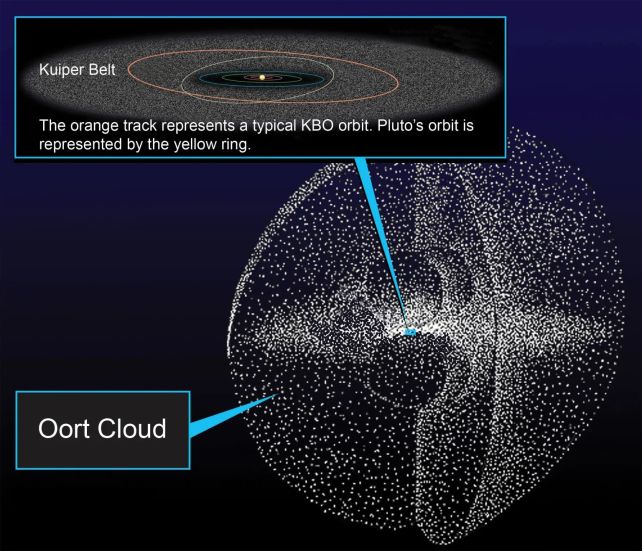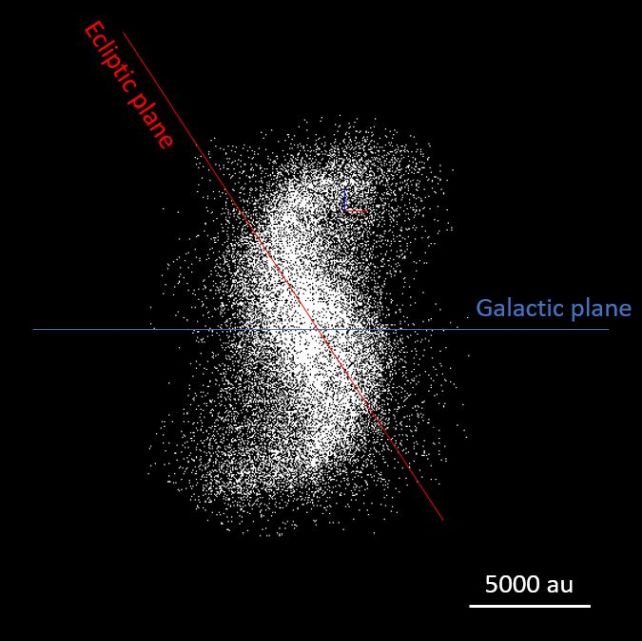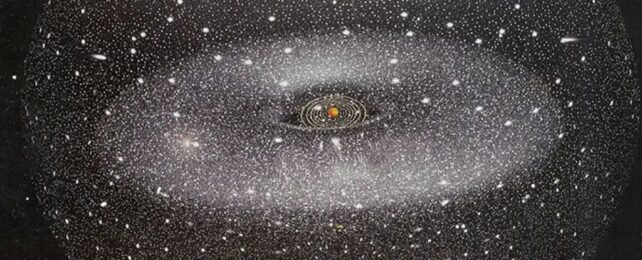The edge of the Solar System is a strange place, full of oddities we've only just begun to probe. But perhaps the oddest of all is the Oort Cloud, a vast field of icy debris extending out to 100,000 times the distance between Earth and the Sun.
We have a rough idea of the size and shape of this field, but the fine particulars elude our understanding. Now, a new computational study has revealed a surprising structure – a spiral generated by the tidal forces exerted by the Milky Way galaxy itself.
The finding, in press at The Astrophysical Journal, is currently available on preprint server arXiv.
"As the galactic tide acts to decouple bodies from the scattered disk it creates a spiral structure in physical space that is roughly 15,000 astronomical units in length," writes a team led by astronomer David Nesvorný of the Southwest Research Institute in the US. "The spiral is long-lived and persists in the inner Oort Cloud to the present time."
The outer Solar System is a frontier that is difficult to probe. We know there are lots of small, icy objects out there in the Kuiper Belt out past the orbit of Neptune; and, beyond that, from 1,000 astronomical units to 100,000 astronomical units, spins the Oort Cloud, the far reaches of the Sun's gravitational influence.
It's from here that the Solar System's long-period comets originate, bumped from their orbits and sent careening toward the Sun, releasing streams of gas as their ices sublime.
We know, also, that the Oort Cloud is roughly divided into two parts. The outer portion is huge, a spherical cloud that extends out from around 10,000 astronomical units from the Sun. Interior to that is the inner Oort Cloud. According to simulations, this portion is more of a torus, or donut shape, extending from 1,000 to 10,000 astronomical units.
Most of the long-period comets in the Solar System come from the outer Oort Cloud. The inner region is much more stable. It's closer to the Sun, which means it's more strongly bound by the Sun's gravity; and it's not as prone to disruption by the passing stars that stir up the outer cloud and knock the icy objects out of their normal orbits.
Because of this long-term stability, the inner Oort Cloud is usually modeled as a more-or-less flat disk aligned with the ecliptic plane of the Solar System.

Nesvorný and his colleagues have been studying the inner Oort Cloud for years. In their latest research, they used NASA's Pleiades Supercomputer to simulate the debris field, applying the gravitational effects of the Sun, as well as the external gravitational effects exerted by the Milky Way galaxy itself, and the orbits of the comets.
They simulated the 4.6 billion-year lifespan of the Solar System, from the formation of the Sun from a dense knot of material in a huge molecular cloud of gas and dust. As the Sun formed, the leftover material in that cloud formed the planets, asteroids, comets, and everything else in the Solar System, including the outer Oort Cloud.
But the simulations suggest that the inner Oort Cloud is not a nice, even, toroidal disk at all. Rather, it mirrors the shape of the Milky Way galaxy, with a spiral structure, and a warp to the disk similar to the warp in the galactic disk. The entire disk measures around 15,000 astronomical units in diameter – and it's inclined 30 degrees from the ecliptic plane.

From a distance, it would appear as a spiral, with two twisted arms.
This structure, according to the simulations, emerged early in the Solar System's history, within the first few hundred million years after the formation of the Solar System. It's also remarkably stable – it persists to this day. And, even when stars pass closely by the Solar System, it remains intact, which means that it's not related to the gravitational perturbations induced by passing stars.
To confirm what they were looking at, the researchers went back over the previous studies. All their previous work suggested that the inner Oort Cloud has a spiral shape that persisted through various parameter tweaks to their simulations.
Directly observing, and therefore confirming, this spiral is going to be very difficult, if it's possible at all. But it fits observation data, and its presence in previous studies that weren't even looking for it is interesting.
Unraveling the mysteries of the Oort Cloud means peering back into the Solar System's distant past, and observing the influences at play over the course of its formation and evolution. Sometimes, the difficult thing is worth doing.
The team's research will be published in The Astrophysical Journal, and is available on arXiv.
